Casula: The Powerhouse, a Bushwalk and History
A Self-Guided Walk in Casula
Download the Walking Map and Notes
The Casula Powerhouse Arts Centre is my main reason for exploring Casula today. There’s also an historic farm, a bush walk and the home of a well-known Australian to discover.
Casula Powerhouse Arts Centre
Across the way from the steps at Casula Station the first and most obvious structures are two enormous rusty tanks, covered in graffiti. The silos are “Legal Art Walls” with Tank Rules.

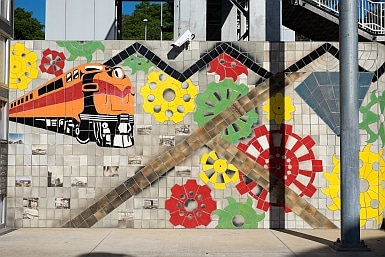
At the foot of the stairs a brightly coloured ceramic mural includes old photos of the Powerhouse. “Progress in Motion” was designed and created by ceramic artist Selma Fida with the assistance of Kathie Raco and Natalie Valiente.
Legal Art Walls
Walking around the base of the tanks, there’s a faint smell of fresh paint. These pieces are recent, one possibly worked on last night. Near the ground, I recognise a concrete balaclava, a piece by Will Coles.
Apart from thick layers of splashed paint on the concrete paving and a blue milk crate, the area is clean. The remains of a rusted metal stairway curls around the tank wall, remnants of the lower steps scarcely visible beneath the paint.
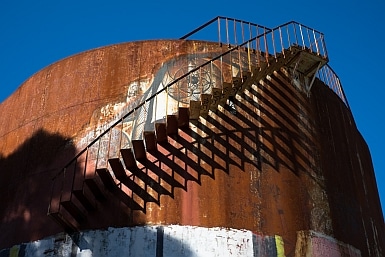

Outside the Powerhouse itself, a sign asks people to keep off the ramp. Will Coles apparently ignored this plea as a broken piece of what looks like one of his concrete artworks is attached to the top of the ramp.
The Casula Powerhouse (once called the Liverpool Powerhouse) was built in 1951 to supplement electricity supply during shortages. Closed in 1975 it remained derelict for around 10 years when Liverpool Residents voted to have it turned into an arts centre.
Bellbird Café
Walking around the grounds I have a feeling that this is a peaceful and positive creative space. The thriving Bellbird Kitchen Garden supplies the café/restaurant with fresh produce and protected birds nest in the eaves above the entrance. Apparently, they are Bellbirds.
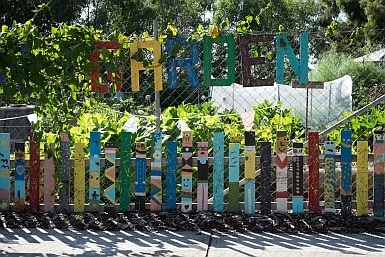
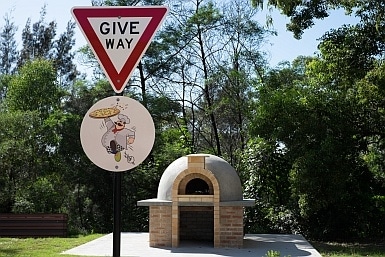
Before I look around, I need breakfast. The Chef brings my eggs on toast, explaining that the side dish of wasabi relish was made from tomatoes from the garden and is “not hot”. Yay…. I’m eating produce from the garden.
Current Exhibitions
The two exhibitions I can see today include one by Rock Photographer, Tony Mott. Not much of a music buff, I can nevertheless feel the energy of the artists in his work. One of Peter Garrett from 1985 grabs my attention. We plan to see Midnight Oil in July at The Big Red Bash in Birdsville later in the year.
“looking here looking north”, the second exhibition, finished yesterday but has not yet been taken down. The varied works by six women from “Woven”, a group of Australian based artists with ties to Indonesia look at cross-cultural forms of belonging and identity.
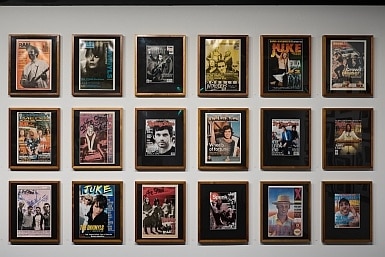

Leaving the Arts Centre, a man approaches me to confirm that this is the Casula Powerhouse “where the citizenship ceremony is taking place”. Hesitantly, he asks “Can I go in there”. Like this man, I was once intimidated by the unfamiliar. My suburban explorations have changed that.
Leacock Regional Park
My route now takes me along a paved path through the Leacock Regional Park. Are those Bellbirds that I can hear? Looking up into the gum leaves above me, a small bird darts between branches. Not for the first time, I wish I was better at bird identification.
The Bellbird Trail
As the Bellbird Trail is only 1.6km return, I decide to take it and divert onto the hard dirt track. There’s only me, birdsong and the occasional butterfly. Then in the distance a beagle tugs on his lead held by an older woman coming down the stepped path towards me. He pulls strongly, almost dragging her over.


There’s an historic underbridge somewhere near here, but I never do find it. Maybe you’ll have better luck.
Back on the main path through Leacock Regional Park, noisy cicadas have replaced the birdsong blending in with the sounds of students from a nearby school.
Historic Glenfield Farm
On my right a few buildings come into view on the ridgeline. They must be part of Glenfield Farm, one of the oldest continuous working farms in Australia. Initially owned by Charles Throsby, the older buildings date back to 1810-1817.
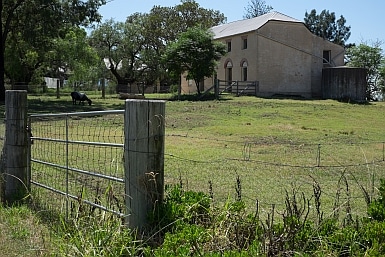
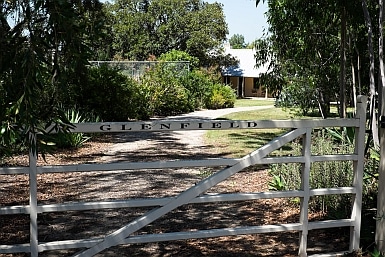
James Leacock purchased the farm in 1919 and farmed it as a cooperative until 1971. Today it is still run as a private cooperative. Fun Fact: James Leacock introduced bottled milk to Australia in 1909.
Walking around the edge of the Park, I discover a type of amphitheatre decorated with mosaic. The artwork by Aboriginal artist, Marie Stucci includes Australian fauna and a vignette of Glenfield Farm.
The Glenfield Farm buildings seem to be in reasonable condition. Two shorn sheep (or are they goats? – they are rather large) graze in the fenced paddock lining the street. One comes up to me to say hello.
Plantings which do a good job of screening the main house from the street, include two bunya pines. Two large cones lie safely on the ground serving as a warning to stay away from the trees. A falling cone can do serious damage.
Suburban Casula
The words “MOUNT’ and ‘OMEI’ on a pair of metal gates suggest something of interest. After a few steps down the driveway, I fear that I may be trespassing and decide to turn back. When I later read that the building once housed an art gallery, I’m sorry, especially as nothing I find can tell me if the place is still in use.

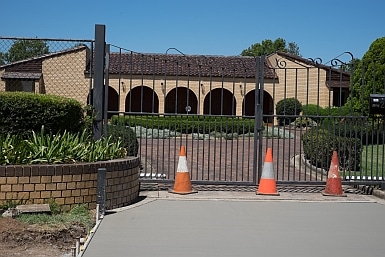
Loudspeakers from the local Catholic school break the silence as they broadcast a series of Hail Mary’s, followed by “Let us pray”. Interesting, when Council regulations prevent the broadcasting of the “Call to Prayer” from Mosques in Sydney.
Bob Ingham’s Home
Bob Ingham, of Ingham Chickens fame, has lived Casula for many years. The house is easily visible from the road. Today, workers smooth freshly laid concrete on the driveway between the road and the gate. I check with one of them if this is Bob Ingham’s home. “It is luv” is the short reply.
As there’s not much more in particular to see in Casula, I walk to the Mall, expecting a bland shopping centre. On a corner pole, a large hand-written sign offers goats for sale.
Casula Mall
Casula Mall is like any other mall in suburban Sydney in that it’s clean, shiny and rather sterile. But a closer look reveals subtle differences. The deli (apparently Serbian) sells Eastern European products. A group of grey-haired men chat on a communal bench. I recognise one or two Polish words. One tells me that they are from all over – Serbia, Croatia, Poland. They have lived here for over 30 years.

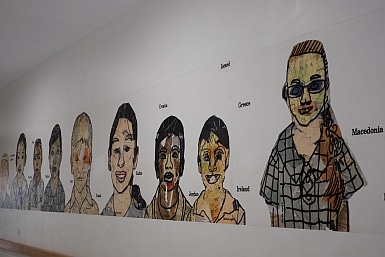
Nearby a group of African women gather their shopping and move off. The butcher sells Halal meat and Muslim women wearing different levels of conservative dress walk past pushing toddlers in strollers.
The mural lining the exit to Ingham Road confirms that the people who live in Casula hail from all over the world. A collaboration between artist Howard Matthew and Year 3 Students of Casula Public School, the artwork “Australian Family Roots” depicts student portraits which indicate their country of origin.
Neat Suburban Streets
Walking suburban streets often provides an insight into a particular suburb. Here, in this part of Casula, the mostly single storey brick veneer homes are well maintained and set back from the street often with no wall or fence. The gardens are neat and lawns mown.


Sam Has lived in Casula all his life
Returning to the station via the Hume Highway, I stop to photograph a closed-up fruit and vegetable roadside stall. A man calls out “Hey, what are you doing?” Once I explain, Sam is happy to chat and shows me some of his old photos. He has lived here for all of his 65 years and has “plenty of stories to tell about Casula”.

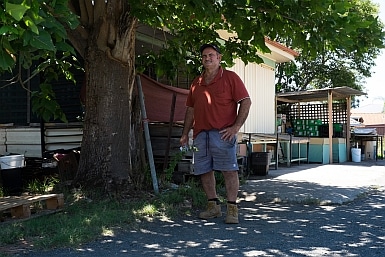
Sam’s parents Vince and Maria settled in Australia many years ago, having migrated from Calabria. They owned and farmed a number of acres in the area and set up one of the first roadside stalls on the Hume hwy. Until she passed away in 2016, Maria could always be found working at the stall which today only trades on weekends.
A Good Day in Casula
I feel rather satisfied with my day exploring Casula. I finally visited the Casula Powerhouse Arts Centre, enjoyed a pleasant bushwalk, learnt some local history and chatted to Sam about his life in Casula.
Useful information:
Casula is 34km South West of the Sydney CBD
It is easy to get to Casula by train. Plan your trip at transportnsw.info
Here are some links to more information on some of the places mentioned above:
Walking Map and Notes
(Note that this is a guide only and that the time indicated on the map does not allow for any stops. I take an average of 4-5 hours when I explore). Use these Day Notes together with the map to assist you. :


Another interesting trip, Joanne. Always enjoy reading about your adventures. I live in Wollongong and have always wanted to explore Sydney. Have you done a walk in Balmain?
Thanks Lyn, glad you enjoy them. Yes, I did walk through Balmain and made some interesting discoveries. The link to the post is on my home page or search Balmain….
Thank you Jo.
Your descriptions just get me in and I want to visit. I like the artwork “Australian Family Roots” and must head to Casula soon.
I’m glad to hear it. So often I leave home to explore a suburb not expecting much and when I get there I find plenty that interests me.
I’m glad to hear it Loretta. So often I leave home to explore a suburb not expecting much and when I get there I find plenty that interests me.
Great use for an old powerhouse, I love that it’s a vibrant art center today. Leacock Regional Park and the Bellbird trail look lovely. Thanks for another great post.
Thanks Bernadette.
Mt Omei was first established as a scientific laboratory by Wolf Klaphake. After his death his widow Alice, an accomplished artist, turned his laboratory into an art gallery. Mount Omei had a second life: as the centre of the art scene in Sydney’s southwest.
Van Klaphake who has lived there since 1949 the son of a scientist father and his mother who started the art gallery in the 70’s.
The Modern Art Gallery was gifted to and now owned by the State Government is being assessed for heritage value by National Parks.
Van Klaphake, now 69 years old, has been asked to leave the property and is deeply concerned regarding the future of Mount Omei. “We always envisaged that it would become an artists precinct and continue to support emerging artists in the region. I’ve lived here since I was 2 years old. I’m concerned the property is earmarked for demolition.”
Hello Gail and thanks for that background information. What you write is concerning – hopefully locals and artists will be able to successfully challenge any proposed demolition. Joanne